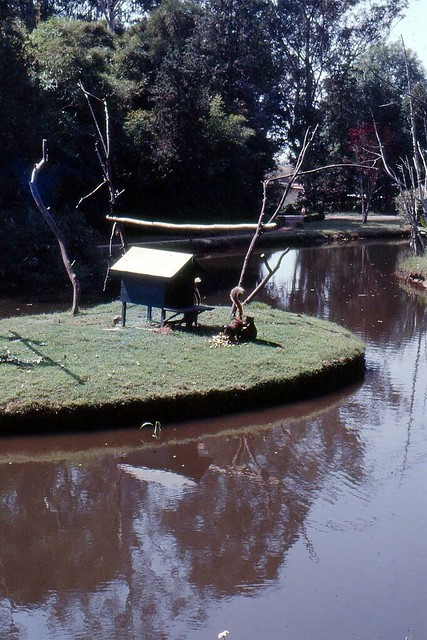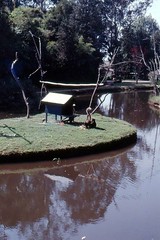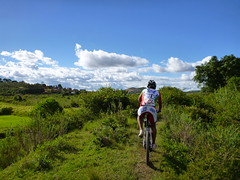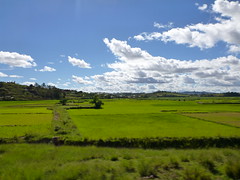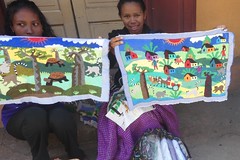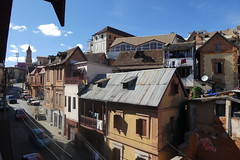Antananarivo
Antananarivo (French: Tananarive, French: [tananaʁiv]), also known by its colonial shorthand form Tana, is the capital and largest city of Madagascar. The administrative area of the city, known as Antananarivo-Renivohitra ("Antananarivo-Mother Hill" or "Antananarivo-Capital"), is the capital of Analamanga region. The city sits at above sea level in the center of the island, the highest national capital by elevation among the island countries. It has been the country's largest population center since at least the 18th century. The presidency, National Assembly, Senate and Supreme Court are located there, as are 21 diplomatic missions and the headquarters of many national and international businesses and NGOs. It has more universities, nightclubs, art venues, and medical services than any city on the island. Several national and local sports teams, including the championship-winning national rugby team, the Makis are based here.
Antananarivo was historically the capital of the Merina people, who continue to form the majority of the city's 1,275,207 (2018 Census) inhabitants. The surrounding urban areas have a total metropolitan population approaching three million. All eighteen Malagasy ethnic groups, as well as residents of Chinese, Indian, European and other origins, are represented in the city. It was founded circa 1610, when the Merina King Andrianjaka (1612–1630) expelled the Vazimba inhabitants of the village of Analamanga. Declaring it the site of his capital, Andrianjaka built a rova (fortified royal dwelling) that expanded to become the royal palaces of the Kingdom of Imerina. The city retained the name Analamanga until the reign of King Andriamasinavalona (1675–1710), who renamed it Antananarivo ("City of the Thousand") in honor of Andrianjaka's soldiers.
The city served as the capital of the Kingdom of Imerina until 1710 when Imerina split into four warring quadrants. Antananarivo became the capital of the southern quadrant until 1794, when King Andrianampoinimerina of Ambohimanga captured the province and restored it as the capital of a united Kingdom of Imerina, also bringing neighboring ethnic groups under Merina control. These conquests continued under his son, Radama I, who eventually controlled over two-thirds of the island, leading him to be considered the King of Madagascar by European diplomats. Antananarivo remained the island's capital after Madagascar was colonized by the French in 1897, and after independence in 1960.
The city is now managed by the Commune Urbaine d'Antananarivo (CUA) under the direction of its President of the Special Delegation, Ny Havana Andriamanjato, appointed in March 2014. Limited funds and mismanagement have hampered consecutive CUA efforts to manage overcrowding and traffic, waste management, pollution, security, public water and electricity, and other challenges linked to explosive population growth. Major historic landmarks and attractions in the city include the reconstructed royal palaces and the Andafiavaratra Palace, the tomb of Rainiharo, Tsimbazaza Zoo, Mahamasina Stadium, Lake Anosy, four 19th-century martyr churches, and the Museum of Art and Archaeology.
Pronunciation and etymology
The English pronunciation of Antananarivo is English: /ˌæntəˌnænəˈrv/ or English: /ˌntəˌnnəˈrv/. The Malagasy pronunciation is Malagasy: [antananaˈrivʷ], and the pronunciation of the old French name Tananarive is English: /təˌnænəˈrv/ or English: /ˌtænənəˈrv/ in English and French: [tananaʁiv] in French.
Antananarivo was originally the site of a town called Analamanga, meaning "Blue Forest" in the Central Highlands dialect of the Malagasy language. Analamanga was established by a community of Vazimba, the island's first occupants. Merina King Andrianjaka, who migrated to the region from the southeast coast, seized the location as the site of his capital city. According to oral history, he deployed a garrison of 1,000 soldiers to successfully capture and guard the site. The hill and its city retained the name Analamanga until the reign of King Andriamasinavalona, who renamed it Antananarivo ("City of the Thousand") in honor of Andrianjaka's soldiers.
History
Kingdom of Imerina
Antananarivo was already a major city before the colonial era. After expelling the Vazimba who inhabited the town at the peak of Analamanga hill, Andrianjaka chose the site for his rova (fortified royal compound), which expanded over time to enclose the royal palaces and the tombs of Merina royalty. The city was established in around 1610 or 1625 according to varying accounts. Early Merina kings used fanampoana (statute labor) to construct a massive system of irrigated paddy fields and dikes around the city to provide adequate rice for the growing population. These paddy fields, of which the largest is called the Betsimitatatra, continue to produce rice.
Successive Merina sovereigns ruled over the Kingdom of Imerina from Analamanga through King Andriamasinavalona's reign. This sovereign gave the growing city its current name; he established the Andohalo town square outside the town gate, where all successive sovereigns delivered their royal speeches and announcements to the public, and assigned the names of numerous locations within the city based on the names of similar sites in the nearby village of Antananarivokely. Andriamasinavalona designated specific territories for the hova (commoners) and each andriana (noble) subcaste, both within the neighborhoods of Antananarivo and in the countryside surrounding the capital. These territorial divisions were strictly enforced; members of subcastes were required to live within their designated territories and were not authorized to stay for extended periods in the territories reserved for others. Numerous fady (taboos), including injunctions against the construction of wooden houses by non-nobles and the presence of swine within the city limits, were imposed.
Upon Andriamasinavalona's death in 1710, Imerina split into four warring quadrants, and Antananarivo was made the capital of the southern district. During the 77-year civil war that followed, the eastern district's capital at Ambohimanga rose in prominence. The last king of Ambohimanga, Andrianampoinimerina, successfully conquered Antananarivo in 1793; he reunited the provinces of Imerina, ending the civil war. He moved the kingdom's political capital back to Antananarivo in 1794, and declared Ambohimanga the kingdom's spiritual capital, a role it still maintains. Andrianampoinimerina created a large marketplace in Analakely, establishing the city's economic center.
Kingdom of Madagascar
By the time Andrianampoinimerina's son Radama I had ascended the throne upon his father's death in 1810, Antananarivo was the largest and most economically important city on the island, with a population of over 80,000 inhabitants. Radama opened the city to the first European settlers, artisan missionaries of the London Missionary Society (LMS) who arrived in 1820 and opened the city's first public schools. James Cameron introduced brickmaking to the island and created Lake Anosy to generate hydraulic power for industrial manufacturing. Radama established a military training ground on a flat plain called Mahamasina at the base of Analamanga near the lake. Radama's subjugation of other Malagasy ethnic groups brought nearly two-thirds of the island under his control. The British diplomats who concluded trade treaties with Radama recognized him as the "ruler of Madagascar", a position he and his successors claimed despite never managing to impose their authority over the larger portion of the island's south. Thereafter, Merina sovereigns declared Antananarivo the capital of the entire island.
Radama's successor Ranavalona I invited a shipwrecked craftsman named Jean Laborde to construct the tomb of Prime Minister Rainiharo, and Manjakamiadana (built 1839–1841), the largest palace at the Rova. Laborde also produced a wide range of industrial products at factories in the highland village Mantasoa and a foundry in the Antananarivo neighborhood of Isoraka. Ranavalona oversaw improvements to the city's infrastructure, including the construction of the city's two largest staircases at Antaninarenina and Ambondrona, which connect la ville moyenne ("the middle town") to the central marketplace at Analakely. In 1867, following a series of fires in the capital, Queen Ranavalona II issued a royal decree that permitted the use of stone and brick construction in buildings other than tombs. LMS missionaries' first brick house was built in 1869; it bore a blend of English, Creole, and Malagasy design and served as a model for a new style of house that rapidly spread throughout the capital and across the highlands. Termed the trano gasy ("Malagasy house"), it is typically a two-story, brick building with four columns on the front that support a wooden veranda. In the latter third of the 19th century, these houses quickly replaced most of the traditional wooden houses of the city's aristocratic class. The growing number of Christians in Imerina prompted the construction of stone churches throughout the highlands, as well as four memorial churches on key sites of martyrdom among early Malagasy Christians under the reign of Ranavalona I.
Until the mid-19th century, the city remained largely concentrated around the Rova of Antananarivo on the highest peak, an area today referred to as la haute ville or la haute ("upper town"). As the population grew, the city expanded to the west; by the late 19th century it extended to the northern hilltop neighborhood of Andohalo, an area of low prestige until British missionaries made it their preferred residential district and built one of the city's memorial churches here from 1863 to 1872. From 1864 to 1894, Prime Minister Rainilaiarivony governed Madagascar alongside three successive queens, Rasoherina, Ranavalona II and Ranavalona III, effecting policies that further transformed the city. In 1881, he reinstated man…
Hotels Antananarivo
 Radisson Serviced Apartments Antananarivo City CentreAntananarivo
Radisson Serviced Apartments Antananarivo City CentreAntananarivo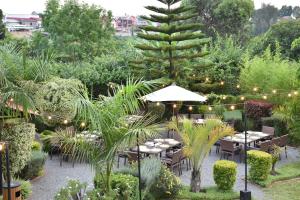 San Cristobal Boutique Hotel - Ivato AirportAntananarivo
San Cristobal Boutique Hotel - Ivato AirportAntananarivo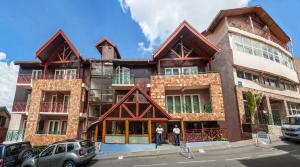 Hôtel & Spa PalissandreAntananarivo
Hôtel & Spa PalissandreAntananarivo Le Grand Mellis Hôtel & SpaAntananarivo
Le Grand Mellis Hôtel & SpaAntananarivo Hotel BrajasAntananarivo
Hotel BrajasAntananarivo Radisson Hotel Tamboho Waterfront AntananarivoAntananarivo
Radisson Hotel Tamboho Waterfront AntananarivoAntananarivo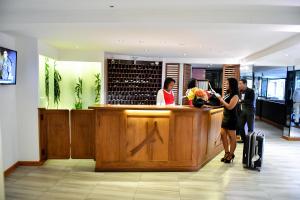 Anjary HotelAntananarivo
Anjary HotelAntananarivo Nosy Manga - Hotel Ivato AirportAntananarivo
Nosy Manga - Hotel Ivato AirportAntananarivo
Looking for places related to Antananarivo?
Those are other destinations to find places related to Antananarivo:
